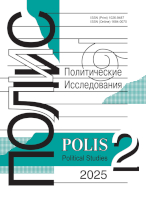Evaluation of Power Distribution among the European Political Groups in the European Parliament in 1979-2014
Kamalova R.U.,
M.A. (Econ.), Research Assistant, Lecturer, National Research University Higher School of Economics, rkamalova@hse.ru
DOI: 10.17976/jpps/2016.04.12
Kamalova R.U. Evaluation of Power Distribution among the European Political Groups in the European Parliament in 1979-2014. – Polis. Political Studies. 2016. No. 4. https://doi.org/10.17976/jpps/2016.04.12
The author analyzes the power distribution among political groups in the European Parliament from 1979 till 2014. Agent’s voting power is treated as the capability to influence the result of collective decision-making process. Often the voting power is not equal to votes share the agent possess. We obtain the values of classical and modified power indices for European political groups and compare their performance. The Banzhaf power index is employed to measure European political groups’ a priori power that does not impose any restrictions on coalition formation, and power indices that take into account groups’ preferences in coalition formation in order to measure actual voting power. Classical power indices are calculated using only votes’ distribution in the committee and a quota to pass a decision. Pairwise preferences allow to have respect to different willingness of groups to form a single coalition. In this paper preferences are modeled using the roll-call data from the votings on important issues of European politics. The less popular is the MP’s position, the smaller is the number of coalitions she can enter and the less is the voting power. We demonstrate that factions can exploit their position and acquire higher relative power than both share of seats and the Banzhaf index measures, and the Liberal group of the European Parliament forming coalitions with both partners from the left and the right is the case. Conversely, hard restrictions on formation of coalitions due to ideological differences can lead to less actual voting power than a priori.
See also:
Akhremenko A.S., Petrov A.P.,
Political institutions, efficiency and deprivation: essay of analogue computation. – Polis. Political Studies. 2012. No6
Bartenev V.I.,
Domestic political determinants of foreign aid instruments: a model kit. – Polis. Political Studies. 2014. No5
Melville A.Yu., Ilyin M.V., Meleshkina E.Yu., Mironyuk M.G., Polunin Yu.A., Timofeev I.N.,
Essay of Countries Classification. – Polis. Political Studies. 2006. No5
Etzrodt Ch.,
Managing liberal democracy – influence of secret elite networks in U.S. governments 1901-2021. – Polis. Political Studies. 2022. No6
Lebedeva M.M.,
Resources of influence in world politics. – Polis. Political Studies. 2014. No1





.jpg)






 print
print
.jpg)
.jpg)